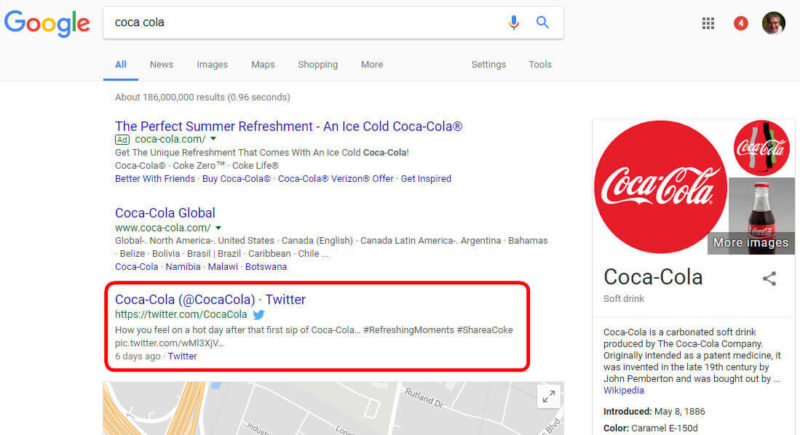
Twitter is one of my top slam-dunk assets for trying to displace negative content in search results. If your reputation has been harmed by some negative content that ranks when your name is searched, a strong Twitter account could be one of your primary resources for pushing the bad stuff lower on Google and Bing. Unfortunately, many individuals, small businesses and reputation agencies do a poor job of optimizing Twitter profiles to enable this to happen. Read on for my ninja-level tricks for Twitter SEO!
When searching for the names of individuals and businesses in search engines, Twitter accounts can appear on page one of Google and Bing if they have been properly optimized. For example, a search for Coca-Cola shows the brand’s main Twitter account on page one in the second position, just below the corporation’s listing for their official website.

In another example from Bing, if you search for Pepsi, you’ll find the official Twitter account of the brand appearing on page one for its name searches.

It’s probably borderline unremarkable to report that a search for “Trump” in either Google or Bing brings up President Trump’s Twitter account listing within the top two or three positions in the search results. But if you search on Google for other big names, you will often find that their Twitter accounts are ranking high as well.
In the example below, featuring the CEO of Tesla cars, Elon Musk, Google has evaluated his tweets to be so salient for his name search that a carousel of them are displayed in the search results, directly below his Twitter account listing.

Of course, these are astronomically popular Twitter accounts for celebrity individuals and strong brands with sophisticated social media management. However, even lesser-known names can achieve placement on page one in search engines. And, if you’re on page one, you then have a good chance of using your Twitter account to displace anything negative about you on the first page.
But this can’t happen if the Twitter account is not properly optimized. So, I’ll launch straight into some ninja tricks for maximizing the ranking power of your Twitter profile.
Optimize your Twitter handle!
I’d count this as one of the two most influential and critical elements for your Twitter optimization effort. Your handle, also known as your username, is incorporated by Twitter into your profile URLs and page titles. It also can appear numerous times in the visible text of the profile, and in links and titles pointing from elsewhere to your page.
To best optimize the handle for rankings of your name, you need to craft the handle to be spelled as closely as possible to the version of your name that people type in when searching for you. People who don’t understand search engines get this wrong all the time. Here are some tips on crafting good names:
- Again, imitate the version of your name that people use to search for you. (People often leave off words like “Inc.” and “Company” when searching.) The ideal naming convention is to spell out your name, leaving out any spaces. The closer you match your spelling, the more search engines are likely to evaluate the handle to be highly relevant for your searches (e.g., @chrissmith).
- If your ideal name configuration is unavailable, which is more likely the more common your name is, then you will have to craft a variation on it. Try to choose an abbreviation that’s as close to the original name as possible. The higher the degree of similarity, the more relevant the search engines will consider the name compared with your actual name. Craft a name that may look like yours if read rapidly, and then test it by using that name to search in Google. If Google automatically associates the alternate version with your website and other online identity materials, then chances are good that you’re on the right track.
- If your name is longer than the 15 characters allotted by Twitter — which happens ALL the time — you will obviously have to abbreviate it. Again, craft this abbreviated name carefully and test it in Google. For instance, if I tried to use my full name without spaces, it would be: @chrissilversmith. At 16 characters, it’s one character too long to be accepted by Twitter. Instead, I might choose to use @chrissilversmth or @chrissilvrsmith.
- People love to generate “cute” Twitter handles that may not even closely resemble their actual names, and they can still rank in search (if other factors and the popularity of the profile are sufficient). You can see my Twitter handle of “Si1very” for an example of this — by the time I joined Twitter, it was difficult to get precise matches for common combos of names like “Chris,” “Silver” and “Smith.” My Twitter profile is otherwise fairly well-optimized, so I can get away with this. But if you’re working hard to get your profile to rank well in Google, DO NOT USE CUTE TWITTER HANDLES that don’t closely match your name!
- Do not add emojis to your username. It may look fun, but the added characters could cause your name to appear to be a less relevant keyword match when people search for you online. If you want to experiment with this later on, after you’ve solved your reputation issues, go for it. But, it could otherwise be sand-bagging your efforts.
- It’s tempting to use underscores for multi-word names to take the place of spaces (e.g., @chris_silver). Avoid doing this because Google does not treat the underscore as a “white space” character like spaces, periods, dashes and so on. It’s unfortunate that Twitter does not allow one to use dashes. In rare cases where it may be the best option available, you may use the underscore, but be aware that it only provides a fuzzy match relevancy that can be very weak — so, you need to focus on shoring up all other factors to ensure the page ranks well for your name searches.
Optimize your full name
In addition to the Username field, Twitter provides a “Full Name” field (some people refer to it as a “headline”). The Full Name appears prominently at the top of your profile below your profile avatar pic, and also appears with your avatar icon on all of your tweets.
The Full Name is quite important for a few reasons, including: 1) the name becomes incorporated into the profile page’s Title text, along with the username; 2) it’s displayed in larger text near the top of the page within an <h1> headline tag; and 3) it appears with all of your tweets, and this text is anchor text everywhere your tweets may appear, linking back directly to your profile page.
So, the Full Name helps reinforce for search engines what your name is, and therefore what keyword sequence the page should be considered most relevant for. As with the Username field, one has limited characters to use, albeit it’s longer than the usernames, being 20 characters long, maximum.
Make the Full Name imitate your actual name that people search on as closely as possible — hopefully the 20 characters are sufficient length to hold your full name. If not, you’ll need to abbreviate it in some way.
Leave out nonessential words, and experiment by searching on the name variations to see how Google may evaluate the sequence — does Google already associate the name you craft with your existing online identify materials? If so, that’s a very good sign.
Optimize the ‘Bio’ description field
This description field is yet another area for adding some keywords related to you. If your name is so long as to not be included in the Username and Full Name fields without abbreviating, definitely reiterate the full name in the Bio, at the beginning of the text field. Otherwise, the bio can allow you to include other combination keywords that can be valuable to your online identity and representation in the search results.
The field should certainly describe succinctly who and what you are. But you could also include the name and Twitter handle of your company, if you’re an individual, or the name of the city where you’re located if you’re a local company. Any other keywords that may be mentioned in combination with your name in searches could also be included here. (Very oddly, I note that Twitter does not use the Meta Description tag on its profile pages — something that seems like a glaring missed opportunity from a search optimization perspective. If they used it, the bio text would seem a natural fit for all or a portion of that Meta Description. Hmph!)
Fill in the Link URL and Location fields
These should be no-brainers, but they apparently aren’t, since some individuals and even businesses, will leave these blank. Filling in your Link field with your website URL can strengthen its rankings in search. Please be sure to use the proper, canonical URL for this.
[Read the full article on Search Engine Land.]
Some opinions expressed in this article may be those of a guest author and not necessarily Marketing Land. Staff authors are listed here.
About The Author

Popular Stories
Related Topics

Thanks , I have just been searching for info about this subject for ages and yours is the best I’ve came upon so far. But, what in regards to the bottom line? Are you sure in regards to the source?
whoah this blog is fantastic i like studying your posts. Keep up the great paintings! You know, a lot of individuals are searching around for this information, you could aid them greatly.
Very good information. Lucky me I came across your blog by chance (stumbleupon). I’ve saved it for later!